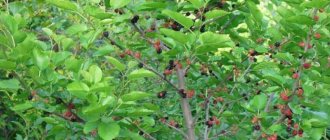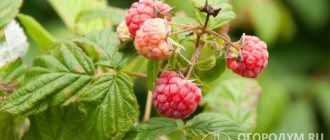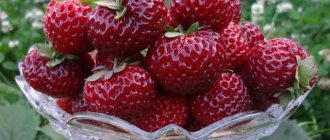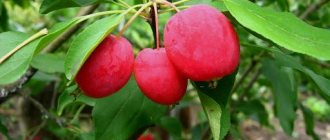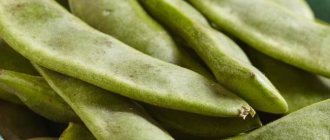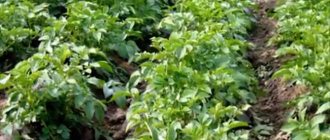4.7
(123)
Intriguing title, isn't it? :))
The full title of this interesting note is: Do not buy mulberry seedlings until you know about this interesting fruit plant.
And you can find out here and now - in this author’s short but interesting note by a naturalist from Siberia. Read carefully and understand the meaning of the intriguing title...
At the beginning of the note about the varietal diversity of mulberries, I will place this brief remark, because I know from experience that now there are many busy, rushing people - this is a sign of our time, not carefully or not fully reading the articles (diagonally). This is essentially the answer to numerous questions.
You can buy mulberries in Siberia, in Barnaul, from us. Only proven winter-hardy varieties. Which ones - read this article and find out.
And if you live in Moscow and are looking on the Internet for where to buy mulberries in Moscow, or indeed in any region of Russia, except the North itself, and want to buy mulberry seedlings, contact us too. The assortment will not disappoint (if everything is not sold out, this also happens due to the influx of orders).
I will immediately answer numerous questions about what we do not sell:
- - mulberry cuttings
- - mulberries
- - mulberry seeds
We sell only mulberry seedlings. Our mulberry varieties are listed in the note.
So let's get to the point.
This plant appeared in my garden 5 years ago. Barnaul is the south of Western Siberia. But the place where my garden is located, where this plant grows, is truly hellish. The microclimate is very harsh, even in comparison with the city of Barnaul itself, it is much harsher, and what can we say about our “souths” - Biysk, Belokurikha, village. Altai is simply a REAL paradise for Siberian gardening (I have something to compare it with, believe me).
So, this plant - mulberry (an alternative name is mulberry) feels very well, even in this place that is not entirely suitable for gardening, very comfortable - it blooms and bears fruit well every year and without problems!
It is very important that the gardener purchases varietal plants, and not those obtained from seeds - then the varietal characteristics of the mother plant are preserved. Our plants (selected winter-hardy varieties) are NOT at all similar to their southern namesakes growing in the south of Russia and Ukraine (but not only there) - there they are huge trees, but here they are bushes 2-3 meters high.
I grow many varieties of this species with fruits of 3 colors - white, black, pink. But in fact, all this is WHITE mulberry, there is also BLACK mulberry. The trick is that the color in the name is not the color of the berries, but is determined by the color of the bark! White mulberry has light bark (light gray, beige), while black mulberry has dark bark. White mulberry is winter-hardy, and black mulberry is heat-loving.
On the Internet (in search results and in articles on this culture), it is customary, although not academically correct, to use terms based on the color of the berries: white mulberries with white fruits, black mulberries with black ones, pink ones with pink ones. For the average person, this is probably more correct, because it’s clearer... What do we, gardeners, care about the color of the bark? Berries are important to us!
black mulberry
I will list the varieties I have that have already been proven to grow in our harsh conditions (all varieties are early):
First, I’ll list the varieties that are “heard of”, that is, at least widespread
- Black Baroness (black fruits)
- Smuglyanka (black fruits)
- Smolenskaya rosea (pink fruits)
- Honey (white fruits)
And these varieties are rarely seen anywhere
5. Pink Baroness (pink fruits). Large-fruited variety.
6. Queen (white fruits). Large-fruited variety.
There are other varieties, but they are still under observation (in variety testing)
The long journey of the “berry of life” to Europe
Silkworm caterpillars feed on mulberry leaves. According to legend, the cocoon of one of them dates back to about 3 thousand years BC. e. ended up in the tea of the Chinese princess Xi Ling Shi, which as a result allowed China to take possession of the secret of silk production. For a long time, this secret was kept in the strictest confidence, and attempts to smuggle silkworm eggs (as well as mulberry seedlings themselves) outside the country were punishable by death.
Only in the 4th century AD. e. silkworms were presented to the king of Bukhara by his future bride, after which silk, and with it mulberry, appeared in:
- Byzantium;
- Venice;
- France and Russia.
The mulberry tree is a sacred plant of the East. It is used to make amulets against evil spirits and amulets symbolizing respect for older relatives.
During the reign of Ivan the Terrible, valuable fabric was produced at a silkworm factory special for royalty. Later, under Peter 1, cutting down the mulberry tree was prohibited, and the scope of its use expanded: musical instruments, household utensils and some household items began to be cut from durable and pliable wood.
Silkworm
Description and varieties
Black mulberry is a deciduous tree of the Mulberry family. Its alternative name is mulberry. The birthplace of the culture is South-West Asia. It was from there that it was transported to the west. The plant is cultivated for its tasty and healthy berries. Its wood is heavy and dense. It is used to create musical instruments, furniture and building materials. In the Russian Federation, harvesting mulberry wood is punishable.
Features of distribution and care
Southern heat-loving crop is common in dry subtropical climates:
- North America,
- Asia,
- Africa.
In the middle zone, mulberry practically does not take root. Optimal conditions for seedlings in Russian regions are on the Black Sea coast and further to Sakhalin Island.
Mulberry care includes:
- watering (from mid-spring to June);
- weeding;
- fertilizing (when planting in April, it is carried out until mid-summer);
- pruning (all branches of young mulberries up to 1.5 m high are cut off for their further proper growth; in October, green shoots that are vulnerable to frost are removed);
- pest control.
Mulberries are planted in the fall, before cold weather and rain, or in mid-spring. For planting, do not choose poor sandy and swampy soil, as well as windy places.
Planting black mulberry
The crop is planted in both spring and autumn. In the first case, the optimal time is before the start of sap flow. Planting work should be completed by mid-April. Spring planting is more suitable for the middle zone, where frosts in early autumn are not uncommon. In warmer areas, preference is given to autumn planting, since the plant that survived the winter has taken root and, if cultivation practices are followed, will not die.
Site selection
Sunny areas protected from drafts and cold, northern winds are suitable for mulberries. The tree is undemanding in terms of soil composition, but the structure must be loose and provide free access of oxygen to the roots. If groundwater lies close, it is worth looking for another site, since the mulberry tree does not tolerate waterlogged soil.
Planting material
For planting, seedlings with open and closed root systems are used. In the first case, the roots are carefully examined so that there are no signs of damage to them by diseases. If the mulberry is in a container, you need to inspect the earthen ball. It should be dense, which indicates that the seedling has been transplanted into a container for a long time, where it has successfully taken root and continues to grow.
They purchase planting material from nurseries that breed mulberries or specialized garden centers to eliminate the possibility of unscrupulous employees selling the wrong variety or even crop. Two-year-old seedlings demonstrate high survival rate. All branches must be healthy, without mechanical damage.
Disembarkation rules
Planting work takes several days. Sequencing:
- A week before planting, holes are dug with dimensions of 70 x 70 cm, depth - at least half a meter.
- An interval of 3-5 m is maintained between copies.
- A mixture of extracted soil and humus with the addition of superphosphate in the amount of 70 g is sent into the pit, forming a mound.
- A seedling with straightened roots is placed on the substrate and sprinkled with fertile soil.
- The soil in the tree trunk circle is compacted and moistened.
For your information!
To prevent excessive evaporation of moisture and speed up rooting, the soil under the tree is mulched with peat or sawdust.
Mulberry varieties
In Russia, two types of mulberry predominate:
- black;
- white.
In addition to the characteristic color of the berries, the trees differ in the color of their bark.
Black mulberry
Several varieties of black mulberry are common in Russian regions:
- Black Baroness is a rare variety that can tolerate low temperatures. The sweet berries ripen in early July and reach 4 cm in length.
- Khersonskaya is a low-growing frost-resistant plant up to 3 m high. The fruits are large - up to 5.5 cm.
- Smuglyanka is a hybrid variety obtained as a result of selection with white mulberry. The leaves are large, rough, with jagged edges. The height of an adult plant reaches 15 m. The fruits are fleshy and light-colored.
- Staromoskovskaya is a variety of self-fertile mulberry that does not require pollination. It has a spherical crown. It reaches a height of 10 m. Sweet and sour berries grow up to 3 cm long.
Black mulberry is native to Afghanistan, Iran, and India.
The culture can withstand air pollution, but does not show good frost resistance, taking a long time to recover from temperature fluctuations.
Varieties of white mulberry
Unlike black mulberry, white mulberry leaves are softer and more suitable as food for silkworms. It was this culture that was initially protected from outsiders in the countries of the East.
The bark of the trees has a light shade:
- brown-gray;
- grey-green;
- reddish-gray.
Common varieties:
- Weeping - the width of the crown of a three-meter shrub reaches 2 m. Flexible long branches descend to the ground. After planting, fruits appear in the third year (after grafting) or in the fifth year (when planting cuttings).
- White Honey is the result of selection of several varieties of white mulberry. Has a pyramidal crown. The berries are soft, poorly stored and transported.
- Victoria is an easy-to-care dwarf plant with large yellow or light beige berries. The fruits are not stored.
The taste of the berries depends on the specific type, and may resemble a hybrid of blackberries and raspberries. The color of the fruit depends on the mulberry variety.
White Honey
Cultivation care
The mulberry tree develops well even with minimal care. The average life cycle reaches two hundred years. However, if the crop is properly cared for, it will consistently produce a harvest for about a century. It is necessary to more carefully monitor young specimens, which over time will only need feeding: most representatives of the crop are drought-resistant and have excellent immunity.
Watering
The mulberry tree needs additional moisture only after planting and during periods of severe drought. If there has been no precipitation for a long time, but July is already coming to an end, you should not water the mulberries. Also, irrigation for adult plants is not required if the winter was snowy and precipitation did not take long. Grown trees, as a rule, are not watered due to the high endurance characteristic of the crop.
Soil treatment
When seedlings begin to grow, they require more nutrients and moisture. They are taken from the cultivated plant by weeds, which are systematically weeded out from the tree trunk. After precipitation or irrigation, the soil under the tree crown must be loosened to maintain high aeration. In the southern regions, where soil drought is often observed, the ground around the trunk is mulched to prevent excessive evaporation of moisture.
Feeding and fertilizers
To ensure intensive vegetation and increase productivity, mulberries are fed with organic and mineral fertilizers. They begin to enrich the soil, if nutritional complexes were added during planting, only from the second year of development. In spring, nitrogen-containing fertilizers are used, since this macronutrient stimulates the growth of green mass. Phosphorus and potassium are added to the budding and flowering phase, which are responsible for the intensity and duration of fruiting.
Trimming
Mulberries are pruned during the dormant period. In spring, a shaping and rejuvenating haircut is carried out. Weeping varieties also require thinning pruning, when shoots that thicken the crown or grow in the wrong direction are removed. In the fall, mulberries are pruned for sanitary purposes, removing damaged, injured branches. The formation of the crown begins after the tree reaches a height of one and a half meters.
Preparing for winter
Frost-resistant varieties are prepared for winter only when the plants have not reached five years old. The standard is wrapped in several layers of covering material. It is also recommended to bend them to the ground and cover them using spruce branches. To prevent the root system from being damaged by frost, the tree trunk circles are mulched with a thick layer of peat. Alternatively, sawdust can be used.
For your information!
Since mulberries reach an impressive height, heat-loving varieties should not be grown in cold areas: they cannot be completely protected from frost.
Composition and beneficial properties of mulberry
Mulberries consist of 20% sugar. The remaining share comes from components such as:
- vitamins (groups A, B, C, E, K and PP);
- minerals;
- citric and malic acid;
- antioxidant resveratrol.
Given their rich composition, mulberries are recommended for pregnant women to prevent fetal development disorders. Also, the benefits of mulberries for the body include processes such as:
- activation of hematopoiesis;
- acceleration of metabolism;
- reducing blood cholesterol levels.
Mulberry juice has antiseptic and bactericidal properties, so it is used to gargle the throat and mouth for periodontal disease, throat diseases and stomatitis. Decoctions of mulberry roots and bark have an antipyretic effect.
In white and black fruits, the amount of valuable components is almost identical, but the properties of the berries differ: white ones strengthen, black ones act as a laxative.
Diseases and pests
If the mulberry is grown according to the rules, it is healthy and has strong immunity. However, under unfavorable weather conditions or errors during cultivation, the tree can be affected by harmful organisms. Of the diseases, root rot is the most common, while bacteriosis, powdery mildew, small leaves and curl are less common. The development of the first is provoked by systematic waterlogging or planting in an area with close groundwater. Among the pests are moths, beetles, spider mites, scale insects, and beetles.
To reduce the risk of tree damage from pathogenic organisms, preventive treatments must be carried out regularly. Both the plant itself and the soil under the crown should be sprayed. For treatments, tank mixtures of insecticides and fungicides are used. The optimal timing is at the beginning of April, when the buds have not yet begun to swell. Also, preventive measures are advisable after the growing season ends, when the tree sheds its leaves and plunges into the stage of stagnation.
For your information!
For spraying in early spring, Bordeaux mixture is used in combination with a systemic insecticide.
Growing a healthy and productive mulberry tree on your plot is not difficult. The main thing is to plant the desired variety, taking into account the agroclimatic characteristics of the growing region, and follow the requirements for mulberry cultivation.
Application
The scope of application of mulberries is not limited to cooking. Its fruits are actively used in:
- cosmetology;
- winemaking;
- folk medicine.
Leaves remain the only food product for silkworm caterpillars, and strong and flexible wood is in demand in the woodworking industry.
For problem skin
White mulberry berries are used to make cleansing and pore-tightening facial masks, and its leaves are used to make compresses that eliminate traces of acne and eczema. Masks are also made from the fruits for shine and thickness of hair.
In conservation
For the winter, mulberry jam is prepared using three methods of processing berries. Their:
- knead into jam or jam;
- digested in assorted berries;
- left whole.
Citric acid and freshly squeezed juice will rid the preparation of freshness.
Mulberry jam without cooking
A simple way to harvest valuable mulberries does not require cooking or clogging. Ingredients used:
- granulated sugar - 2kg;
- mulberry fruit – 1 kg.
Cooking process:
- The berries are sorted, leaving only whole ones and without signs of wilting. Rinse. Dry by spreading on a paper towel.
- The prepared mulberries are ground in a blender. Cover with sugar.
- The mass is placed in sterilized jars and stored in the cold under paper or plastic lids.
To prevent the jam from separating, leave the chopped polydrupes in the pan for a day, stirring occasionally.
In winemaking
Mulberries go well with raspberries, blackberries, cherry plums, and plums. To make homemade mulberry wine, in addition to 2 kg of the main product you will need:
- raisins – 100 g;
- sugar – 1.5 kg;
- citric acid – 2 tbsp;
- water – 5 l.
Recipe step by step:
- The collected berries are cleaned of debris, but not washed, preserving natural yeast. Mix with raisins, citric acid and sugar. Fill with water and leave to release the juice.
- The container is covered with gauze and left to ferment for 2-3 days. The mass is stirred 2 times a day.
- After foam appears, filter. The cake is thrown away. The juice is left for further fermentation in a container with a water seal (or a rubber glove stretched over the neck). The fermentation process can take 1-1.5 months.
- After sediment appears, the cleared wine is carefully poured into another container, filtered again and left for 6 months in a cool place.
About once a month you need to strain the wine, removing possible sediment.
Reproduction
You can grow a mulberry tree yourself using a vegetative or generative method. Growing seedlings from seeds is rarely used because this method is very labor-intensive. It does not guarantee the preservation of varietal characteristics. In addition, fruiting of such trees begins much later. Mulberry propagation by vegetative methods is much more effective: cuttings, layering, grafting.
Growing from seeds
Seed material is prepared in mid-October. The seeds are removed from fresh fruits, clearing them of pulp. Then they are dipped into a solution of the drug “Epin”, “Zircon” or any other growth stimulator and left for a period of 4 to 8 hours. Afterwards, the dried seeds are sown in open ground.
Advice!
If sowing is postponed until spring, preliminary preparation is performed. To do this, the seeds are immersed in ice water for a day. Then take them out and lower them into a liquid heated to +53°C for the same time. Only after this they begin planting.
A well-lit area of the garden is allocated for sowing mulberries. The soil is dug up, leveled and furrows 3 cm deep are made. They are moistened with water and the seeds are laid out, keeping an interval of 5 cm. After leveling the soil, the bed is watered again and covered with mulch. If the seeds are sown in autumn, the protective layer is made thicker. With the onset of spring after the emergence of seedlings, they are provided with regular care. It consists of regular moistening, weeding, and fertilizing.
By autumn, the grown seedlings are planted in a permanent place. Between them leave 3 to 5 m of free space. Fruiting of mulberries grown from seeds begins only after 5 years.
Growing from root shoots
Mulberry produces abundant root shoots. Usually it is removed so as not to thicken the plantings. But if the main trunk is damaged, root suckers are used for propagation. To do this, choose the most developed shoots with a strong stem. It is left, the remaining specimens are uprooted. Also, excess offspring can be planted in a new place as seedlings. To do this, they are dug up along with the roots and the shoots are shortened by a third. A plant obtained from root shoots completely inherits its parental characteristics.
Graft
The mulberry tree is grafted using all known methods. But it’s easier and more efficient to perform copulation. There are two options for performing the procedure:
- In simple copulation, cuttings of the rootstock and scion of equal thickness are connected. They make identical oblique cuts with a length equal to four diameters of the parts being connected. Open surfaces are aligned and tightly tied with elastic tape.
- With improved copulation, they make not a smooth cut on the rootstock, but with a tongue in the form of a small transverse cut, stepping back from the edge by a third. The same is done with the scion. But the tongue is done on the other side. After alignment, the slices are tightly connected to each other. The splice area is also wrapped with tape.
Reproduction by layering
For rooting on the mother plant, select a branch located lower than the others. It is bent to the ground, making an incision in the bark at the point of contact with the soil. The position of the shoot is fixed with a special pin. From above this area is covered with a layer of earth. During the summer, the bent shoot develops its own root system. By autumn, the branch is separated from the mother tree and transplanted to a permanent place.
Cuttings
Green cuttings are cut during the active growing season in June or July. They should be 15 to 20 cm long with 2-3 leaves. The leaf blades are cut in half. The cuttings are rooted in a greenhouse in fertile soil. They are placed at an angle of 45° to a depth of 3 cm. Seedlings are transferred to open ground only the next year after the formation of a strong root system. Instead of green cuttings, lignified ones are sometimes used. They are rooted in the same way, but the process takes longer.
Important!
Only self-rooted mulberries are propagated by cuttings. For successful rooting, fog-forming units are installed in the greenhouse to create high humidity.
How to store
Fresh berries are stored for up to 2-4 hours before they begin to release juice and lose their presentation. But they can be prepared for the winter in two ways - drying or freezing.
Dried mulberries are made in 2 stages:
- The fruits are left for 7-14 days in a ventilated and sunny place.
- The berries are then placed in the oven and dried for an hour at 30 degrees Celsius with the door open.
Variety selection by region
When choosing a mulberry tree, be sure to take into account climatic features. In the Moscow region and the central zone the climate is unstable. There is a risk of return frosts. For the Moscow region, self-fertile mulberry varieties are the best option. Such plantings do not depend on a pollinator or other mulberries in the garden. There will be a harvest anyway. You can give preference, for example, to Smuglyanka, Nadiya, Vladimirskaya.
In Ukraine, for example, in Artemovsk, Nadiya and Ukrainskaya 6 grow beautifully. Mulberries grow there without any problems.
The Black Prince is growing in the North of Russia. There the plant is carefully insulated for the winter. High risk of freezing.
Where to buy mulberry seedlings
Among the places where you can buy mulberries for planting are online stores for gardeners and summer residents.
| Variety | Price per seedling, rub. |
| "White Baroness" | 590 |
| "White honey" | 399 |
| "Pink Princess" | 399 |
| "White Spirata" | 1999 |
| Black large-fruited "Morion" | 499 |
It is believed that Alexander the Great drank vodka made from sweet mulberries on the eve of victorious battles, which gave him strength and also served as a kind of amulet in battle. Nowadays, the need for this has disappeared, but decoctions, juice and infusions of mulberries have found application in other areas of life. And decorative varieties of mulberry are used to decorate the landscape design of city parks and gardens.
What to cook from mulberries?
Mulberries are very tasty fresh; they are widely used in cooking, added to pies, yoghurts and desserts. The fruits make very tasty wine, vodka, liqueurs, syrups, tinctures, and artificial bekmes honey. Jams, preserves, pastes, compotes are made from mulberries, ice cream, sorbet, jelly, jellies and cocktails are made. The roots and leaves are used to prepare healthy and aromatic tea and medicinal mixtures.
Berries are combined with various products:
- Walnut;
- vanilla;
- wheat and rye flour;
- muesli and oatmeal;
- lemon;
- blackberries, black currants, elderberries;
- sugar;
- venison, game, hare;
- blackcurrant, elderberry and blackberry liqueur;
- port wine, cognac;
- cream, ice cream;
- cow's and soy milk;
- yogurt, butter.
Mulberry jelly
Ingredients:
- 4 tbsp. l. lemon juice;
- 2 cups mulberries;
- 3 tbsp. l. starch;
- ½ cup Sahara;
- 2 l. water.
Preparation:
- Remove the tails from the berries, rinse in cold water and drain in a colander.
- Grind the mulberries through a sieve or use a blender.
- Pour a glass of cold water over the starch.
- Pour water over the berry puree, add sugar and bring to a boil.
- Pour starch in a thin stream and mix, add lemon juice.
- When the mixture boils, remove from the stove.
- Pour the jelly into a jug and let cool.
Mulberry ice cream
Ingredients:
- 6 tbsp. l. yogurt;
- 1 banana;
- 100 g mulberries;
- 1 tbsp. l. rose jam.
Preparation:
- Rinse the berries and remove the stems, place in a blender bowl.
- Peel and chop the banana, add to the blender with the mulberries and grind until smooth.
- Add yogurt and jam to the mixture, beat again until smooth.
- Pour into molds and cover with cling film.
- Leave the ice cream in the freezer for 4 hours or overnight.
What are the benefits of black mulberry?
Mulberry fruits are rich in nutrients. The calorie content of the product is low: 50.4 kcal per 100 g. Black mulberry is used for weight loss and in the diet menu for the treatment and prevention of various diseases. It removes waste and toxins from the body well and gently cleanses the intestines.
The benefits of black mulberry are explained by its composition, which includes:
- resveratrol is a plant antioxidant that protects against the spread of bacteria and fungi;
- vitamins A, B1, B3, C, PP, K;
- beta-carotene;
- potassium, calcium, magnesium, sodium, zinc, selenium, iron;
- organic acids;
- mono- and disaccharides.
The fruits of the plant are valued for their high potassium content. They also have a diuretic, choleretic effect and successfully relieve inflammation. They are also taken for edema, heart defects, to relieve pain and shortness of breath. Unripe berries are also used for diarrhea, as they have an astringent effect. Ripe fruits help relieve constipation.
Important! If you have a medical condition, you should consult your doctor before consuming mulberries.
Mulberry leaves in the form of a decoction produce an antipyretic effect. Fresh juice from the leaves relieves toothache. Berry extract is effective for colds, vitamin deficiency, low immunity, and nervous system disorders.
Black mulberry bark also has beneficial properties. Decoctions based on it are used for kidney disease. Bark powder helps heal wounds and burns. An infusion of the roots is useful for bronchial asthma and colds, hypertension, and heart disease.
Growing
When growing mulberries, all the most important activities must be carried out in the first seasons after planting. At this time, watering is carried out during dry periods, and most importantly, formative pruning. The future appearance of your tree depends on it. If you do not trim the mulberry on time, it can reach the height of a three-story house, which will further lead to inconvenience in handling the tree. And in the conditions of central Russia and Siberia, this, among other things, can lead to freezing of the branches.
You should start feeding the tree only from the third year of cultivation, and then only if external manifestations of a lack of nutrients are visible. Excessive fertilization reduces fertility and frost resistance and leads to rapid vegetative growth.
White mulberry, how to grow
White mulberry is a rather demanding and heat-loving plant, but its cultivation is not difficult, and if we provide the tree with the proper conditions, it will not cause us much trouble.
It is best to place mulberries in the garden in a very light, warm and wind-protected location so that they are better protected from freezing. Mulberry propagation by cuttings should be used in moderately fertile, permeable and not too wet soil with a neutral pH.
The tree tolerates drying out very well and is not susceptible to diseases and pests, so it does not require special care.
White mulberry can be grown in the garden both as an agricultural plant (it begins to bear fruit in the fifth year of cultivation or earlier) and as an ornamental plant.
Mulberry in landscape design
Mulberry has found wide application in landscape design. Breeders have developed many varieties for these purposes. Trees not only decorate gardens and parks, but also strengthen the coastal areas of canals and reservoirs, and are planted as shelterbelts.
Amateur gardeners can grow mulberries on their own in their garden plots. Seedlings can be purchased in specialized stores or nurseries. An unpretentious tree will require a minimum of care and will provide a healthy and tasty harvest of berries.
